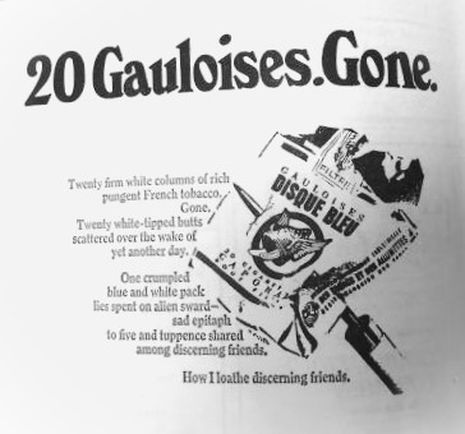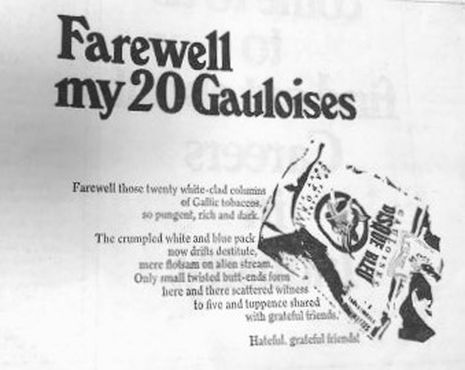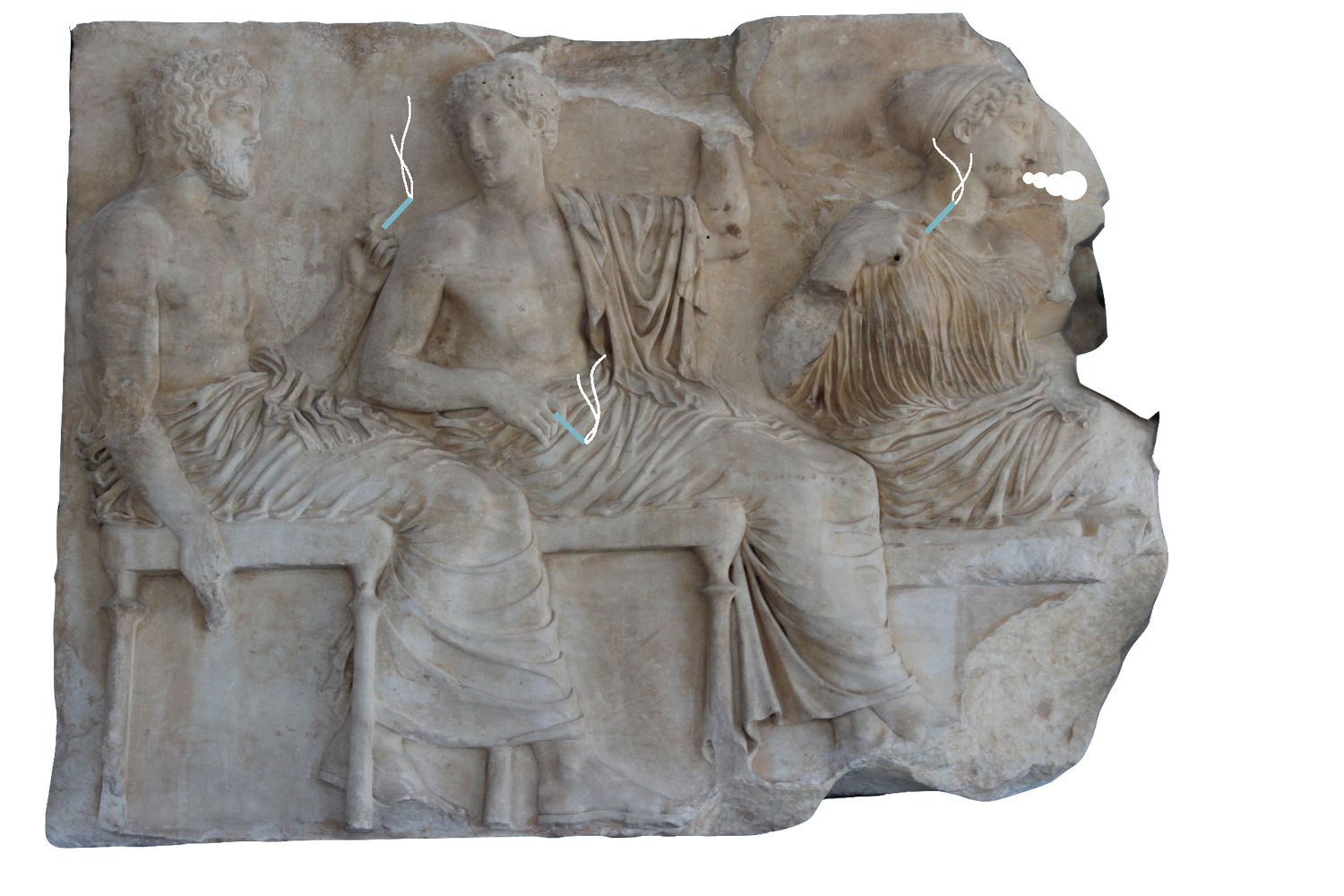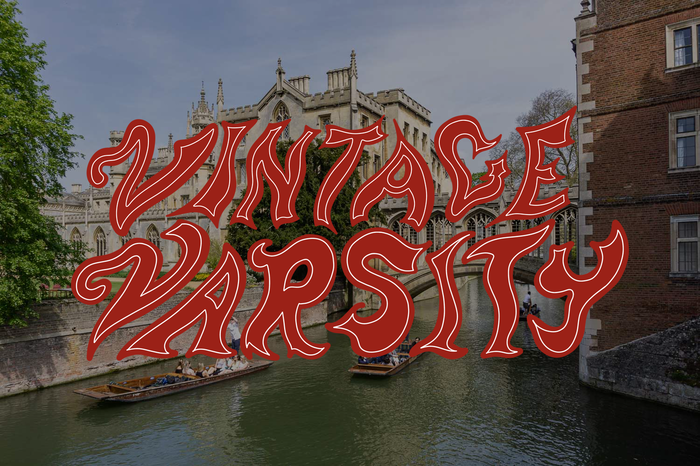I first felt I was really at Cambridge about a week into term. Walking around college still felt as though I’d escaped from a guided tour; matriculation photos were yet to be hidden behind bookshelves in faint embarasment, and in the meantime, my newly found friends and I had gone to a pub. Cigarettes were passed around, and the boy I was sat next to asked me if I smoked. ‘Me neither’, he replied, lighting up a cigarette: ‘well, only in a Parisian way’.
This, essentially, was what the literature had promised. It seemed likely he’d read his fair share of Oscar Wilde. Was maybe even the next Oscar Wilde. And the cigarette, hanging from his hand like an afterthought, only seemed to complete the image. Since becoming Varsity Archivist, this image is one I’ve tried to find in our historic print - and it has proved more difficult than I expected. It’s not that Varsity doesn’t live up to the literature - the front page of our second ever edition (a report of a student in a silk dressing gown being thrown into King’s fountain) might actually be directly ripped from Brideshead Revisited – but smoking itself is rarely referenced explicitly.
“Every pub is ‘smoke filled’ beforehand, and the atmosphere one of ‘smoky intimacy’”
Eventually, I began to realise that the absence of articles about smoking wasn’t an indication of a smokeless past, but rather the opposite: cigarettes aren’t referenced explicitly, because they’re just part of the scenery. Smoking is a descriptive shortcut for the time-pressed student journo (or, to avoid tautology, the student journo); every pub is ‘smoke filled’ beforehand, the atmosphere one of ‘smoky intimacy’. The brief and deeply unpopular provost of King’s, who repainted the college bar (worried that the previous red was "intimidating to right wing students") even described the bar in its pre-reactionary era as a ‘den of drinking and smoking’. Initially frustrated that my search results for ‘smoke’ in the digital archives were overwhelmingly overturning Footlights Smokers, it took me an embarrassingly long time to realise that this was for the same reason as the pubs – that the questionable improv and RP punchlines of Footlights history were all delivered through clouds of smoke.

Beyond the articles and going well back to the 50’s, Varsity regularly advertises cigarette brands. Most notable are the almost-extinct ‘Gaulouises’; originally a filterless cigarette, favoured by Satre, Orwell, Ravel, Lennon, Picasso - and anyone else who’d visited Paris. They briefly made international news in 2016, when the French government considered banning the brand for being ‘too stylish and cool’, and is used in Varsity well before then as a synonym for the self-involved part-time-Parisian on their year abroad; had I arrived in Cambridge 20 years earlier, perhaps my friend would have offered me one.
Articles explicitly about smoking arrive in the 2000s. We can speculate that this is partly self-romanticism of the student press – a fresher’s guide from 2004 for example, writes that ‘if you don’t drink coffee or smoke cigarettes, it’s probably best to start sooner rather than later, otherwise you will look out of place with your clean teeth and calm demeanour … both make you impossibly cool and alert, and are a good substitute for food’. Generally however, there is a more evidential explanation: this is the result of the smoking ban. Statistics finally prove what leafing through the yellowed pages of pre-millennium Varsity could not; in June 2004 (when the ban was proposed), Cambridge is hailed ‘smoking capital of Britain’ accompanied by research showing that ‘people living in the CB2 1 area, which includes colleges such as Trinity, King’s [Caius] and Downing, spend more on cigarettes each year than anybody else in the country.’
The ban therefore, when it is first suggested, is deeply controversial. Varsity quotes a 70 year old smoker in an edition from 2006, as he protests: ‘I think they’ve got a cheek; it’s taking away a freedom’. He’s speaking in response to the banning of smoking within Addenbrooke’s hospital. Some of the most vicious and splenetic student press I have ever read is in this line. The objections of ‘Proud Smoker William Gietzmann’ (‘first they banned hunting with dogs … and now this’), tame in comparison to those made by Mary Bowers (a former editor of Varsity, later to work for The Times and be run over by a bus), who writes that ‘Britons are growing up, like good little children, under the sheltered wing of Daddy Blair in our New Labour nursery’, and ends the article with a threat to ‘a peachy-skinned, clear voiced and inwardly trembling member of the JCR’ that she will ‘put a pack of Camels in their pigeonhole’’.

Looking past the nicotine-stained sputum of the student press, there appears to be a genuine concern from wider Cambridge about the impact that the ban will have on the local economy. Pub landlords are interviewed in 2005: Paul Wells, (a local brewer) anticipated a ‘25-30 per cent reduction in trade if the ban goes ahead’; Dan Lacy (manager of the Fort St George on Midsummer Common) is similarly pessimistic. Mary Bowers summarises the future with a sketch of her friend Richard: ‘the last bastion of ill-health-for-pleasure, [standing] outside in the rain, waving through the smeary window, soggy Sovereign in hand. It is a sorry sight indeed.’
Much as some inner literary part of me thought Cambridge would be draped in chain-smoking dilettantes, realistically, this is the image I expected too. Nobody smoked at my school – least of all the nerds who wanted to go to Oxbridge (my mate Noah and I). Me and Cambridgeshire GP Paul Sackin had been reading from the same NHS waiting-room posters; he writes in 2005 (in response to the pub landlords) that ‘a lot of smokers welcome a total ban because most of them want to stop and they find it very, very difficult’. With a Grandfather and Uncle who’d both struggled to quit smoking in my lifetime, this didn’t seem unlikely.
And yet (discarding the papers, and returning to the pub I began with), practically everyone I know in Cambridge smokes. Admittedly, I mainly know humanities students: there is something to be said for the reason that so few medics smoke. A medical answer exists too, to the question of why so many students in Cambridge smoke. However - not only would it make for a boring article – but I don’t think nicotine addiction explains what both Paul Sackin and Dan Lacy got wrong in 2005.
I know very few genuine ‘pack-a-day’ smokers in Cambridge. I myself am an intermittent smoker at best, and am currently writing with a terrible throat infection, so have vowed never to smoke again. In place of my own experience I have sought that of others; Izzy gave me an extra-strong snus at my girlfriend’s 20th birthday party which caused me to throw up, and ever since I’ve felt that she would be suitable for this project. She is a genuine smoker, in a way that most Cambridge students are not. Ironically though, the proof of her addiction is that most of her nicotine intake isn’t through the filter of a cigarette. To smoke the equivalent of Izzy’s daily nicotine intake (including snus and gum), we worked out you’d have to smoke about a pack and a half a day.
There are almost certainly students here who could afford the price (which has been rising steeply ever since the ban) of a pack and a half a day: my suspicion however, is that students with that sort of money are fueling rather more expensive addictions. For most of us, paradoxically, affording a nicotine addiction requires giving up cigarettes – or at least smoking considerably fewer of them. And every student I’ve spoken to (who isn’t from London), tells me that at home, vaping is far more common. Last time I visited home, an old friend arrived at the pub wielding what looked like a lightsaber and gave me their last pack of cigarettes.
This is the test of a nicotine addiction that most Cambridge students fail: because they prioritise the aesthetic over the addiction. As Izzy puts it (and with apologies to my friend), vaping ‘a raspberry-peach-lemon-cotton-candy elf bar makes you look like an absolute twat’. Universally, the students I’ve talked to about this article despise vapes: for their environmental consequences; for their unresearched effects; but always principally, for their image.
Image is a problem for Cambridge students. As Cambridge students, we are by definition either desperate try-hards, or embarrassingly rich. Many of us are probably both. And it is this image - not the ache of a nicotine addiction - which we hope to escape from when we smoke. As a close friend put it: ‘the middle classes in Cambridge are divided by a) those who love their parents (don’t smoke), and b) those who loathe their parents (do)’. We might add a third category, which probably includes most of Cambridge – c) those who love their parents, but would prefer it if nobody realised (do). Most of Izzy’s friends also ‘took up smoking … almost in an act of rebellion against their parents’, however – she amends - ‘all my friends who are working-class, took up smoking almost in solidarity with their parents, because their parents were smoking and that’s how they got into it’.
“Could there be a drug better designed to dope the Cambridge undergraduate than the cigarette?”
Could there be a drug better designed to dope the Cambridge undergraduate than the cigarette? Simultaneously, one gets to rebel from one’s parents, and appear to be working-class. Forget the fact that most working-class students are smoking through plastic tubes rather than paper ones; as the authors of a pamphlet in the 60’s titled “On the ‘Poverty’ of student life” write, ‘the student Bohemian (and every student likes to pretend that they are a Bohemian at heart) clings desperately to their false and degraded version of individual revolt’. Smoking is just such an act of revolt. It is an aestheticization of poverty; it displays a disregard for authority that no authority would ever care about, and it is irrational. This is perhaps the most important part. It is the opposite of ‘trying hard’: it is a rejection of the sort of worrying about one’s future that consumes the aspirational school child. As Richard Klien (author of ‘Cigarettes are Sublime’) suggests, ‘few people would smoke if cigarettes were actually good for you’.
It is this, that the morose pub owners and hopeful GP’s of 2005 failed to anticipate. The paradox of the cigarette ban is that it has only served to increase the aesthetic potential of the cigarette. And - far from eliminating social smoking, it has given smoking a more defined social role than it previously possessed. Cambridge is a tricky place to fit into, and not only does imbibing a cigarette make you feel for a second as though you might be part of a great chain of smoking thinkers and students, but it makes you part of a group. It has the potential to turn ‘nothing’ into ‘something’ - as I discovered over the holidays, when I found myself smoking just to avoid staring blankly out of my window. Nobody in Cambridge has ever asked me if I’d like to go and stand outside with them for a bit. It is far easier - it turns out - to ask, “shall we go for a smoke?”.


